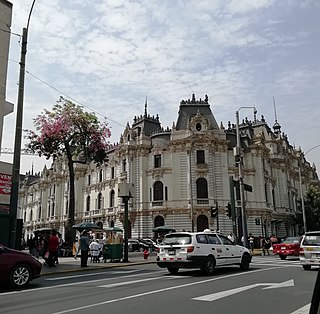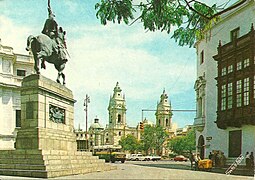
Trujillo is a municipality located in Extremadura, an autonomous community of Spain in the Province of Cáceres. In 2013 the municipality had 9,086 inhabitants. Originally settled on a granite knoll, which was readily fortified, the town now extends to the southeast of its original site. Trujillo is both a centre for tourism, with more than 25 hotels, and a regional market town.

The Government Palace, also known as the House of Pizarro, is the seat of the executive branch of the Peruvian government, and the official residence of the president of Peru. The palace is a stately government building, occupying the northern side of the Plaza Mayor in Peru's capital city, Lima. Set on the Rímac River, the palace occupies the site of a very large huaca that incorporated a shrine to Taulichusco, the last kuraka of Lima.

The Basilica Cathedral of Lima, commonly known as the Metropolitan Cathedral of Lima, is a Roman Catholic cathedral in Lima, Peru. It is the seat of the Archdiocese of Lima. Its construction began in 1535 and finished in 1797, having been built in its present form between 1602 and 1797. Its patron saint is Saint John, Apostle and Evangelist, to whom it is dedicated.

The Jirón de la Unión, or Union Street, is a pedestrian street located in the Historic Centre of Lima, part of the capital of Peru. For many decades it was the most important boulevards of the city, often described as the most aristocratic, where many of the most affluent citizens of the city and most powerful men around the world would meet. Subsequently, with the deterioration of the center of Lima, the Jirón de la Unión lost its aristocratic character and became completely commercialized.

The Archbishop's Palace of Lima, the capital of Peru, is the residence of the Archbishop of Lima, and the administrative headquarters of the Archdiocese of Lima. It is located at the Plaza Mayor, in the Historic Centre of Lima.

The Plaza Mayor, also known as the Plaza de Armas, is the main public square of the historic centre of the city of Lima, Peru. It dates back to the foundation of the city by Francisco Pizarro on January 18, 1535. Delimited by Carabaya, Junín, Huallaga, and Unión streets, it is surrounded by a number of major landmarks, including the Government Palace, the Metropolitan Cathedral, the Archbishop's Palace, the Municipal Palace, and the Palacio de la Unión.

Bolívar Square, also known as Congress Square or Inquisition Square, is a public square located at the second block of Abancay avenue, in the neighbourhood of Barrios Altos, in Lima, Peru. Located three blocks east of the city's main square, it forms part of the city's historic centre. Its other names come from the Legislative Palace, which serves as the seat of the Congress of Peru, and the Former Tribunal of the Inquisition, which once housed both the tribunal and the senate, currently functioning as a museum.

The Palacio Municipal de Lima or City Hall of Lima is a public building that serves as headquarters of the Metropolitan Municipality of Lima. It is located on the street Portal de Escribanos, block 3 of Jirón de la Unión, and in front of the Plaza Mayor of Lima's historic centre.

The Gran Hotel Bolívar is a historic building and three-star hotel located next to San Martín Square in the historic centre of Lima, Peru. Part of a program to modernise the city, it was designed by noted Peruvian architect Rafael Marquina y Bueno and built in state property in 1924 to be the first large, modern hotel built in Lima, and with the specific intent of hosting foreign delegations for the 1924 centennial celebrations of the 1824 Battle of Ayacucho, a decisive military encounter during the Peruvian War of Independence.
The Historic Centre of Trujillo is the main urban area and the most important center of development and unfolding in the Peruvian city of Trujillo located in La Libertad Region. The whole process of its original urban fabric is in elliptical shape surrounded by España Avenue that was built in the wake of the Wall of Trujillo. It houses the seat of city government and other important entities in the locality. In the center of this historic urban area is the Plaza de Armas of Trujillo that was the scene of the Spanish founded of the city in 1534 and the proclamation of the independence of Trujillo on December 29, 1820.

The Plaza Bolognesi is a roundabout located in the Lima District and the Breña District, in the capital of Peru. It is located at the intersection of Brazil Avenue, Arica Avenue, Alfonso Ugarte Avenue, Guzmán Blanco Avenue, and 9 December Avenue.

The Plaza Manco Cápac, formerly the Plaza Leguía, is a public square in Lima. Formerly named after president Augusto B. Leguía, its current name comes from Manco Cápac, the first Sapa Inca of Cuzco.

The Casa de Alcántara was a 16th-century building in the Historic Centre of Lima. It was demolished in 1952 and replaced by the Plaza Pizarro.
The Park of the Wall is a public park located in the central district of Lima, Peru. It was inaugurated in 2004. Within its extension is part of the former Walls of Lima. The park is located between the Rímac River and the historic centre of Lima.

The Equestrian statue of Francisco Pizarro is a series of three bronze equestrian statues of Spanish Conquistador Francisco Pizarro by U.S. sculptor Charles Cary Rumsey. The statues are located in Buffalo, Trujillo and Lima. The latter two cities are Pizarro's places of birth and death, respectively.

Italy Square, formerly known as Saint Anne's Square, is a public square in the Barrios Altos neighbourhood of Lima, Peru. It was the second square built by the Spanish during the colonial era and later served as one of the four squares where the independence of Peru was declared in the city.

The Flag Square is a public square in Lima, Peru. It is located next to the Mateo Salado Huaca at the intersection of Breña, Lima and Pueblo Libre districts.

Jirón Junín is a major street in the Damero de Pizarro, located in the historic centre of Lima, Peru. The street starts at its intersection with the Jirón de la Unión and continues for 19 blocks until it reaches Nicolás Ayllón Avenue.

The Casa del Oidor is a historical building located next to the Plaza Mayor, in the historic centre of Lima, Peru. It is best known for the large balcony that runs through its façade. It is part of the Cultural heritage of Peru.

The Fountain of the Plaza Mayor is located in the square of the same name in the historic centre of Lima, Peru. Originally inaugurated in 1578, it has since been retouched and serves as the square's main feature, itself featuring a statue of Pheme, one of the gods of Ancient Greece.























